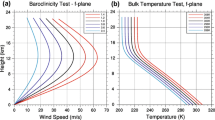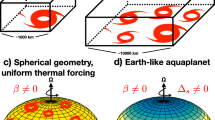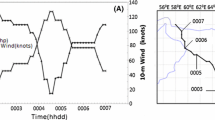Abstract
The precise influence of climate change on extratropical cyclone genesis and evolution is an important (but as yet unsolved) problem, given their physical and economic impact on a large portion of the planet’s population. However, extratropical cyclones are also affected by the competing influences of forcing mechanisms at a wide range of spatial scales, complicating the problem. While the advent of idealized numerical modeling has allowed great strides in addressing these complications and achieving some qualitative consensus in the literature, there is still some quantitative disagreement about response magnitude and where local maxima and minima in the response may be located. Thus, the advantages inherent in the variety of idealized numerical modeling methods used to address this problem are also a drawback, as it can be difficult to draw one-to-one comparisons across experiments. Although the effects of particular model architecture choices such as microphysical and cumulus schemes are well-documented, others are less understood. In this study, we examine the role of Coriolis approximations by comparing a new set of ETC sensitivity experiments using a linear β-plane approximation to an existing set of extratropical sensitivity experiments using a constant f-plane approximation. ETCs within the new β-plane experiment are found to generally decrease in strength with temperature, as measured by both minimum sea level pressure and maximum eddy kinetic energy (EKE). A small increase in EKE is observed at the warmest temperatures, likely due to diabatic influences disrupting flow within the warm conveyor belt. While seemingly contradictory to the previous f-plane results, the two experiments are instead found to be qualitatively similar upon further inspection, with an offset of approximately 8 K. This offset is primarily due to the Coriolis approximations, although the initial stability profile (affected by the Coriolis approximation) has a marginal influence.










Similar content being viewed by others
References
Ahmadi-Givi F, Graig GC, Plant RS (2004) The dynamics of a midlatitude cyclone with very strong latent-heat release. Q J R Meteorol Soc 130:295–323. https://doi.org/10.1256/qj.02.226
Allen MR, Ingram WJ (2002) Constraints on future changes in climate and the hydrologic cycle. Nature 419:224–232. https://doi.org/10.1038/nature01092
Balasubramanian G, Garner ST (1997) The role of momentum fluxes in shaping the life cycle of a baroclinic wave. J Atmos Sci 54:510–533
Boettcher M, Wernli H (2013) A 10-year climatology of diabatic rossby waves in the northern hemisphere. Mon Wea Rev 141:1139–1154
Boettcher M, Wernli H (2015) Diabatic Rossby waves in the southern hemisphere. Q J R Meteorol Soc 141(693):3106–3117
Booth JF, Wang S, Polvani LM (2013) Midlatitude storms in a moister world: lessons from idealized baroclinic life cycle experiments. Clim Dyn 41:787–802
Booth JF, Reider H, Lee DE, Kushnir Y (2015) The paths of extratropical cyclones associated with wintertime high wind events in the Northeast United States. J Appl Meterol Clim 54:1871–1885
Boutle IA (2009) Boundary-layer processes in mid-latitude cyclones. Doctoral dissertation, The University of Reading
Boutle IA, Beare RJ, Belcher SE, Brown AR, Plant RS (2010) The moist boundary layer under a mid-latitude weather system. Boundary-Layer Meteorol 134:367–386
Boutle IA, Belcher SE, Plant RS (2011) Moisture transport in mid-latitude cyclones. Q J R Meteorol Soc 137:360–367
Browning KA (2004) The sting at the end of the tail: damaging winds associated with extratropical cyclones. Q J R Meteorol Soc 130(597):375–399
Catto JL, Jakob C, Berry G, Nicholls N (2012) Relating global precipitation to atmospheric fronts. Geophys Res Lett 39:L10805. https://doi.org/10.1029/2012GL051736
Chagnon JM, Gray SL, Methven J (2013) Diabatic processes modifying potential vorticity in a North Atlantic cyclone. Q J R Meteorol Soc 139:1270–1282. https://doi.org/10.1002/qj.2037
Charney JG, Eliassen A (1964) On the growth of the hurricane depression. J Atmos Sci 21:68–75
Craig G, Cho HR (1988) Cumulus heating and CISK in the extratropical atmosphere. Part I: polar lows and comma clouds. J Atmos Sci 45(19):2622–2640
Davis CA, Emanuel KA (1991) Potential vorticity diagnostics of cyclogenesis. Mon Weather Rev 119:1929–1953. https://doi.org/10.1175/1520-0493(1991)119%3c1929:PVDOC%3e2.0.CO;2
Davis CA, Stoelinga MT, Kuo Y-H (1993) The integrated effect of condensation in numerical simulations of extratropical cyclogenesis. Mon Weather Rev 121:2309–2330. https://doi.org/10.1175/1520-0493(1993)121%3c2309:TIEOCI%3e2.0.CO;2
Dudhia J (1993) A nonhydrostatic version of the Penn State-NCAR mesoscale model: validation tests and simulation of an atlantic cyclone and cold front. Mon Weather Rev 121:1493–1513
Emanuel KA, Fantini M, Thorpe AJ (1987) Baroclinic instability in an environment of small stability to slantwise moist convection. Part I: two-dimensional models. J Atmos Sci 44:1559–1573
Frei C, Schär C, Lüthi D, Davies HC (1998) Heavy precipitation processes in a warmer climate. Geophys Res Lett 25:1431–1434. https://doi.org/10.1029/98GL51099
Grams CM et al (2011) The key role of diabatic processes in modifying the upper-tropospheric wave guide: a North Atlantic case-study. Q J R Meteorol Soc 137:2174–2193. https://doi.org/10.1002/qj.891
Hawcroft MK, Shaffrey LC, Hodges KI, Dacre HF (2012) How much Northern Hemisphere precipitation is associated with extratropical cyclones? Geophys Res Lett 39:L24809. https://doi.org/10.1029/2012GL053866
Hawcroft M, Dacre H, Forbes R, Hodges K, Shaffrey L, Stein T (2017) Using satellite and reanalysis data to evaluate the representation of latent heating in extratropical cyclones in a climate model. Clim Dyn 48:2255–2278
Held I, Soden B (2006) Robust responses of the hydrological cycle to global warming. J Clim 19:5686–5699
Hong S-Y, Noh Y, Dudhia J (2006) A new vertical diffusion package with an explicit treatment of entrainment processes. Mon Weather Rev 134:2318–2341
Igel AL, van den Heever SC (2014) The role of latent heating in warm frontogenesis. Q J R Meteorol Soc 140:139–150. https://doi.org/10.1002/qj.2118
Joos H, Wernli H (2012) Influence of microphysical processes on the potential vorticity development in a warm conveyor belt: a case-study with the limited-area model COSMO. Q J R Meteorol Soc 138:407–418. https://doi.org/10.1002/qj.934
Kain JS, Fritsch JM (1993) Convective parameterization for mesoscale models: the Kain-Fritsch Scheme. In: Emanuel KA, Raymond DJ (eds) The representation of cumulus convection in numerical models. Meteorological monographs, vol 24. American Meteorological Society, Boston, MA, pp 165–170
Kirshbaum DJ, Merlis TM, Gyakum JR, McTaggart-Cowan R (2018) Sensitivity of idealized moist baroclinic waves to environmental temperature and moisture content. J Atmos Sci 75:337–360
Kuo Y-H, Shapiro MA, Donall EG (1991) The interaction between baroclinic and diabatic processes in a numerical simulation of a rapidly intensifying extratropical marine cyclone. Mon Weather Rev 119:368–384
Leckebusch GC, Renggli D, Ulbrich U (2008) Development and application of an objective storm severity measure for the northeast Atlantic region. Meteor. Z 17:575–587. https://doi.org/10.1127/0941-2948/2008/0323
Marciano CG, Lackmann GM, Robinson WA (2015) Changes in US east coast cyclone dynamics with climate change. J Clim 28:468–484. https://doi.org/10.1175/JCLI-D-14-00418.1
Michaelis AC, Willison J, Lackmann GM, Robinson WA (2017) Changes in winter North Atlantic extratropical cyclones in high-resolution regional pseudo–global warming simulations. J Clim 30:6905–6925
Moore RW, Montgomery MT (2004) Reexamining the dynamics of short-scale, diabatic Rossby waves and their role in midlatitude moist cyclogenesis. J Atmos Sci 61:754–768
Moore RW, Montgomery MT (2005) Analysis of an idealized, three-dimensional diabatic Rossby vortex: a coherent structure of the moist baroclinic atmosphere. J Atmos Sci 62:2703–2725
Moore RW, Montgomery MT, Davies H (2013) Genesis criteria for diabatic Rossby vortices: a model study. Mon Weather Rev 141(1):252–263
Morrison H, Curry J, Khvorostyanov V (2005) A new double-moment microphysics parameterization for application in cloud and climate models. Part I: description. J Atmos Sci 62:1665–1677. https://doi.org/10.1175/JAS3446.1
O’Gorman PA, Merlis TM, Singh MS (2018) Increase in the skewness of extratropical vertical velocities with climate warming: fully nonlinear simulations versus moist baroclinic instability. Q J R Meteorol Soc 144:208–217
Overland JE, Wang M (2010) Large-scale atmospheric circulation changes are associated with the recent loss of Arctic sea ice. Tellus 62A:1–9
Parker DJ, Thorpe AJ (1995) Conditional convective heating in a baroclinic atmosphere: a model of convective frontogenesis. J Atmos Sci 52:1699–1711. https://doi.org/10.1175/1520-0469(1995)052%3c1699:CCHIAB%3e2.0.CO;2
Pfahl S, O’Gorman PA, Singh MS (2015) Extratropical cyclones in idealized simulations of changed climates. J Clim 28:9373–9392. https://doi.org/10.1175/JCLI-D-14-00816.1
Polvani LM, Esler JG (2007) Transport and mixing of chemical air masses in idealized baroclinic life cycles. J Geophys Res 112:D23102. https://doi.org/10.1029/2007JD008555
Posselt DJ, Martin JE (2004) The effect of latent heat release on the evolution of a warm occluded thermal structure. Mon Weather Rev 132:578–599. https://doi.org/10.1175/1520-0493(2004)132%3c0578:TEOLHR%3e2.0.CO;2
Ranson M, Kousky C, Ruth M, Jantarasami L, Crimmins A, Tarquinio L (2014) Tropical and extratropical cyclone damages under climate change. Clim Change 127:227–241
Rantanen M, Räisänen J, Sinclair VA, Järvinen H (2019) Sensitivity of idealised baroclinic waves to mean atmospheric temperature and meridional temperature gradient changes. Clim Dyn 52(5–6):2703–2719
Raymond DJ, Jiang H (1990) A theory for long-lived mesoscale convective systems. J Atmos Sci 47:3067–3077
Reed RJ, Simmons AJ, Albright MD, Unden P (1988) The role of latent heat release in explosive cyclogenesis: three examples based on ECMWF operational forecasts. Wea Forecast 3:217–229
Reeves HD, Lackmann GM (2004) An Investigation of the influence of latent heat release on cold-frontal motion. Mon Weather Rev 132:2864–2881
Rossby C-G (1939) Relation between variations in the intensity of the zonal circulation of the atmosphere and the displacements of the semi-permanent centers of action. J Marine Res 2:38–55
Schäfer SA, Voigt A (2018) Radiation weakens idealized midlatitude cyclones. Geophys Res Lett 45:2833–2841
Schemm S, Wernli H, Papritz L (2013) Warm conveyor belts in idealized Moist baroclinic wave simulations. J Atmos Sci 70:627–652. https://doi.org/10.1175/JAS-D-12-0147.1
Screen JA, Simmonds I (2010) The central role of diminishing sea ice in recent Arctic temperature amplification. Nature 464:1334–1337
Screen JA, Simmonds I (2013) Exploring links between Arctic amplification and mid-latitude weather. Geophys Res Lett 40:959–964. https://doi.org/10.1002/grl.50174
Serreze MC, Barry RG (2011) Processes and impacts of Arctic amplification: a research synthesis. Glob Planet Chang 77:85–96
Simmons AJ, Hoskins BJ (1977) Baroclinic instability on the sphere: solutions with a more realistic tropopause. J Atmos Sci 34:581–588
Skamarock WC, Klemp JB, Dudhia J, Gill DO, Barker DM, Duda M, Huang X-Y, Wang W, Powers JG (2008) A description of the advanced research WRF Version 3, NCAR Technical Note http://www.mmm.ucar.edu/people/skamarock/
Snyder C, Lindzen RS (1991) Quasi-geostrophic wave-CISK in an unbounded baroclinic shear. J Atmos Sci 48:78–88
Stoelinga MT (1996) A potential vorticity-based study of the role of diabatic heating and friction in a numerically simulated baroclinic cyclone. Mon Weather Rev 124:849–874. https://doi.org/10.1175/1520-0493(1996)124%3c0849:APVBSO%3e2.0.CO;2
Thorncroft CD, Hoskins BJ, McIntyre ME (1993) Two paradigms of baroclinic-wave life-cycle behaviour. Q J R Meteorol. Soc. 119:17–55. https://doi.org/10.1002/qj.49711950903
Tierney G, 2017: An Examination of Extratropical Cyclone Sensitivity to Enviromental Variability. Doctoral dissertation, University of Michigan
Tierney G, Posselt DJ, Booth JF (2018) An examination of extratropical cyclone response to changes in baroclinicity and temperature in an idealized environment. Clim Dyn 51:3829–3846. https://doi.org/10.1007/s00382-018-4115-5
Ullrich PA, Reed KA, Jablonowski C (2015) Analytical initial conditions and an analysis of baroclinic instability waves in f—and β-plane 3D channel models. Q J R Meteorol Soc 141:2972–2988. https://doi.org/10.1002/qj.2583
Wang S, Polvani LM (2011) Double tropopause formation in idealized baroclinic life cycles: the key role of an initial tropopause inversion layer. J Geophys Res 116:D05108. https://doi.org/10.1029/2010JD015118
Watterson IG (2006) The intensity of precipitation during extra-tropical cyclones in global warming simulations: a link to cyclone intensity? Tellus 58A:82–97
Wernli H, Dirren S, Liniger MA, Zillig M (2002) Dynamical aspects of the life cycle of the winter storm ‘Lothar’ (24–26 December 1999). Q J R Meteorol Soc 128:405–429
Whitaker JS, Snyder C (1993) The effects of spherical geometry on the evolution of baroclinic waves. J Atmos Sci 50:597–612
Willison J, Robinson WA, Lackmann GM (2013) The importance of resolving mesoscale latent heating in the North Atlantic storm track. J Atmos Sci 70:2234–2250. https://doi.org/10.1175/JAS-D-12-0226.1
Acknowledgements
The authors thank the NASA Advanced Supercomputing Division for their help in using the Pleaides supercomputer as well as the University of Michigan’s Advanced Research Computing center for their help with the Flux high-performance computing cluster for their roles in our code refinement and completion of simulations. The authors would also like to acknowledge Shuguang Wang for his role in the development of this modeling framework. The research described in this manuscript was supported by NASA CloudSat/CALIPSO Science Team grant NNX13AQ33G, NASA PMM Science Team grant NNX16AD82G, and NSF grant AGS-1560844. A portion of this research was carried out at the Jet Propulsion Laboratory, California Institute of Technology, under a contract with the National Aeronautics and Space Administration. Finally, the authors appreciate the time, comments, and suggestions of two anonymous reviewers, whose feedback helped to improve the first draft of this manuscript.
Author information
Authors and Affiliations
Corresponding author
Additional information
Publisher's Note
Springer Nature remains neutral with regard to jurisdictional claims in published maps and institutional affiliations.
Appendix: Model initialization equations
Appendix: Model initialization equations
1.1 Initial flow field
As the flow is initiated in a purely zonal orientation, we need only worry about initiating the u-component of the wind, and consider changes only in the latitudinal direction, j, and height, k. Our wind profile takes the functional form:
U0, the speed at the jet maximum, is set to 45 m/s. F(j) and G(k) are functions for the variation with latitudinal direction and height, respectively:
The latitude of the selected row of grid points is specified by lat(j), zz(k) is the height of level k, and zt equals 13 km in these simulations. F(j) is chosen following PE2007, which itself attempts to mimic Thorncroft et al. (1993). G(k) also follows PE2007, which follows a latitude dependence from Simmons and Hoskins (1977). Together these profiles produce a reasonable jet shape, with wind velocity at the surface initialized at 0 m/s.
1.2 Initial temperature field
Finally, we complete the balanced temperature field at initialization. Again, following the appendix of PE2007, we can arrive at a temperature formulation as follows:
The formulation depends on a reference temperature profile valid at the southern boundary, Tr:
and utilizes a correction factor of Tc to iteratively bring the temperature field into balance with the wind field:
where H is the scale height of the atmosphere, set to 7500 m, and R is the gas constant of dry air, 287 J kg−1 K−1. At j = 1, the southern boundary of the domain, Tc is set equal to 0 and the temperature is equal to the reference value. Tc includes the change in jet speed \(\left( {\frac{{{\text{d}}u}}{{{\text{d}}z}}} \right)\), meridional grid spacing used within the model (\(\Delta y\)), and the Coriolis parameter f.
1.3 Moisture initialization
After the dry initialization is complete, moisture is then added; and as in B2013, the initial relative humidity profile is given by:
For all experiments, the surface relative humidity (RH0), is set to 80%, and the moisture scale height (Zt) is set to 12 km.
Rights and permissions
About this article
Cite this article
Tierney, G., Posselt, D.J. & Booth, J.F. The impact of Coriolis approximations on the environmental sensitivity of idealized extratropical cyclones. Clim Dyn 53, 7065–7080 (2019). https://doi.org/10.1007/s00382-019-04976-x
Received:
Accepted:
Published:
Issue Date:
DOI: https://doi.org/10.1007/s00382-019-04976-x




